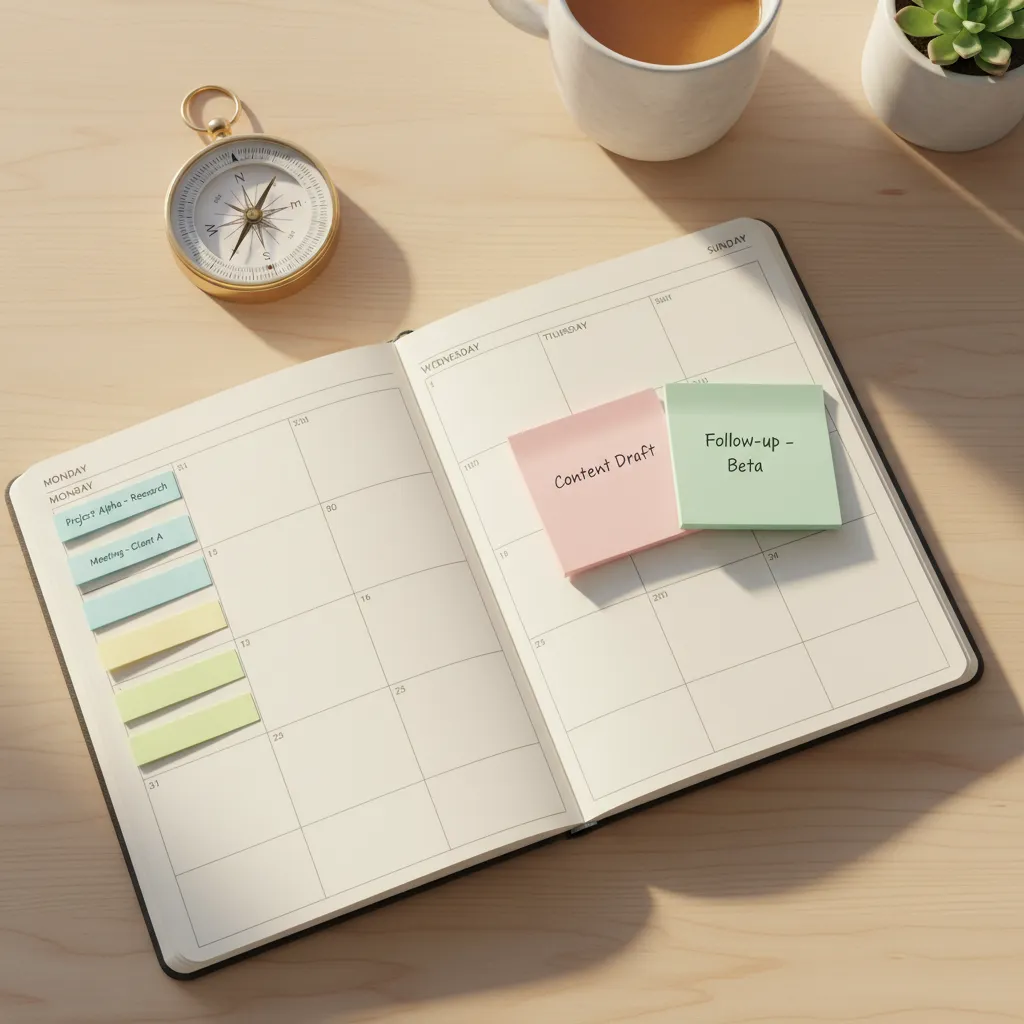
Your calendar feels less like a tool and more like a battlefield. Meetings appear without warning. Your to-do list grows longer by the hour. You start the day with a clear goal but end it wondering where the time went. If you live in a bustling city, you add a commute, unexpected delays, and the constant hum of urgency to the mix. The feeling is universal: you’re busy, but are you productive?
Many time management systems promise a revolution but deliver rigidity. They don’t account for a client call that runs long, a traffic jam on the way to the office, or the simple human need for a break. You’re left feeling like you failed the system, when in reality, the system failed you.
Welcome to a more pragmatic approach. This is your complete guide to time blocking, a method designed for real life. It’s not about creating a perfect, unbreakable schedule. It’s about being intentional with your most valuable resource: your time. This guide will show you how to do time blocking in a way that provides structure without strangling your spontaneity. You will learn to build a schedule that works for you, not against you, transforming your calendar from a source of stress into a map for success.
📚 Table of Contents
- What Is Time Blocking and Why Does It Work?
- Setting Up Your Time Blocking Calendar
- Choose Your Tool: Digital vs. Analog
- Create Your Categories and Color Code Them
- Block in Your Non-Negotiables First
- Embrace Buffer Time
- Executing Your Plan: A Day and a Week with Time Blocking
- Guardrails: Handling the Unpredictable
- Optimization: The Weekly Review
- Time Blocking in Action: Two Scenarios
- Frequently Asked Questions About Time Blocking
- 1. How strict should I be with my time blocks?
- 2. What if my job is entirely reactive or my day is full of meetings?
- 3. How long should a time block be?
- 4. Digital calendar or physical planner? Which is better?
- 5. What if I get distracted or procrastinate during a block?
- Your First Steps to a Time-Blocked Schedule
What Is Time Blocking and Why Does It Work?
At its core, time blocking is the practice of dedicating specific blocks of time in your calendar to particular tasks or activities. Instead of working from a simple to-do list, you assign every item on that list a home in your schedule. A to-do list tells you what you need to do. A time-blocked schedule tells you what you need to do and when and where you will do it.
Imagine your to-do list has “Write project report” on it. That’s a start. A time-blocked calendar would have a specific entry: “9:00 AM – 11:00 AM: Draft Section 1 of Project Report at my desk.” The difference is commitment. You’ve made an appointment with your priorities.
This method is powerful for several psychological reasons. First, it directly combats Parkinson’s Law. This principle, first articulated by Cyril Northcote Parkinson, states that “work expands so as to fill the time available for its completion.” If you give yourself all day to write a report, it will likely take all day. But if you block out a two-hour slot, you create a sense of urgency and focus that encourages efficiency. This is a simple but profound shift in time management.
A close cousin to time blocking is timeboxing, where you set a maximum amount of time for a task and stick to it, regardless of whether it’s “finished.” For example, you might timebox 25 minutes for clearing emails. When the timer goes off, you stop. Time blocking is the container; timeboxing is the limit you place on the work within that container.
Second, time blocking drastically reduces the negative effects of context switching. This is the mental cost of shifting your attention from one unrelated task to another. Every time you jump from an email to a spreadsheet to a chat message, your brain has to reorient itself, costing you time and mental energy. Research supported by organizations like the American Psychological Association has shown that these mental shifts can consume a significant portion of your productive time. By creating dedicated blocks for similar tasks (a practice known as task batching), you stay in one cognitive mode for longer, achieving a state of deep work and producing higher-quality results.
Finally, a time-blocked schedule forces you to be realistic. There are only so many hours in a day. When you try to fit your tasks into a finite schedule, you quickly see if your workload is manageable. This helps you prioritize according to the 80/20 Principle (or Pareto Principle), which suggests that roughly 80% of results come from 20% of the effort. Time blocking encourages you to identify and schedule those high-impact 20% tasks first, ensuring the most important work gets done.

Setting Up Your Time Blocking Calendar
The foundation of a good time blocking system is a well-organized calendar. Whether you prefer a digital tool like Google Calendar or a physical planner, the principles are the same. The goal is to create a clear, at-a-glance view of your day and week. This is your personal time blocking method guide to getting started.
Choose Your Tool: Digital vs. Analog
A digital calendar is often best for professionals and students whose schedules change frequently. It’s easy to drag and drop blocks, set recurring events, and share your availability. An analog planner, on the other hand, can feel more intentional. The physical act of writing down your commitments can make them feel more concrete. There is no right answer; choose the tool you will consistently use.
Create Your Categories and Color Code Them
Start by identifying the major categories of your life. This isn’t just about work. A holistic schedule accounts for all aspects of your well-being. Common categories include:
Deep Work: Cognitively demanding tasks requiring full concentration (e.g., writing, coding, strategic planning). Give this a primary color, like blue.
Shallow Work: Administrative tasks that don’t require intense focus (e.g., email, scheduling, filing). Assign this a less prominent color, like gray.
Meetings & Communication: Calls, video conferences, and in-person meetings. A social color like orange works well.
Personal & Health: Exercise, meals, meditation, appointments. A calming color like green is a great choice.
Learning & Development: Reading, courses, skill practice. Use an inspiring color, perhaps yellow.
Travel & Commute: Time spent getting from one place to another. A neutral color like brown can represent this.
Color-coding transforms your calendar from a wall of text into a visual dashboard of your life. You can instantly see if your week is balanced or if one area is taking over.
Block in Your Non-Negotiables First
Before you schedule any work, block out your personal foundations. This includes sleep, meals, exercise, and family time. For example, block out 10:00 PM to 6:00 AM for sleep. Block out 12:00 PM to 1:00 PM for lunch. Block out your gym session. These are the pillars that support everything else. Protecting this time is critical for preventing burnout, a topic often discussed by health institutions like the National Institutes of Health. Treat these appointments with yourself as seriously as you would a meeting with your boss.
Embrace Buffer Time
One of the biggest mistakes beginners make is scheduling tasks back-to-back. Life doesn’t work that way. Meetings run over. A task takes longer than expected. You need a moment to grab water or stretch. Buffer time is the magic ingredient that makes a schedule flexible. Add 15-minute buffers between major blocks. A 90-minute deep work session should be followed by a 15-minute break. A one-hour meeting should have a buffer before your next task. This gives you breathing room to transition, reset, and handle small interruptions without derailing your entire day.
If you live in a city, blocking out your commute is a non-negotiable buffer. Don’t just assume it takes 30 minutes. Block out 45 minutes on your calendar for “Commute to Office.” This accounts for variability and ensures you don’t start your day already behind schedule.

Executing Your Plan: A Day and a Week with Time Blocking
With your calendar set up, it’s time to put the theory into practice. The goal is not perfection but intentionality. Let’s walk through what a typical day and week might look like for a busy professional using this time management system.
A Sample Time-Blocked Day
6:00 AM – 7:00 AM: Personal Time (Green)
Your day doesn’t start with your phone. Instead, you have a block for a morning routine: meditate, stretch, or read. This sets a calm, proactive tone.
7:00 AM – 8:00 AM: Family & Breakfast (Green)
Dedicated time for breakfast and connecting with family before the workday rush begins.
8:00 AM – 8:45 AM: Commute & Plan (Brown)
You’ve blocked out your travel time. During this commute, you might listen to a podcast or mentally review your top three priorities for the day, which are already in your schedule.
8:45 AM – 9:00 AM: Buffer & Settle In (Gray)
Arrive at the office, grab coffee, and briefly scan emails for anything urgent. This buffer prevents a frantic start.
9:00 AM – 11:00 AM: Deep Work: Project Alpha Report (Blue)
This is your most important task of the day. Notifications are off. Your focus is absolute. You make significant progress because you’ve protected this time.
11:00 AM – 11:15 AM: Break (Green)
A scheduled buffer. You get up, walk around, and don’t check your email.
11:15 AM – 12:00 PM: Shallow Work: Email & Slack (Gray)
You batch your communication. You respond to all important messages in one focused session instead of letting them interrupt your day.
12:00 PM – 1:00 PM: Lunch (Green)
You leave your desk. This is a real break to recharge, not a time to work while eating.
1:00 PM – 2:30 PM: Team Sync Meeting (Orange)
A scheduled meeting block. You come prepared and focused on the agenda.
2:30 PM – 2:45 PM: Buffer (Gray)
Post-meeting time to debrief, update your notes, and transition to the next task.
2:45 PM – 4:15 PM: Deep Work: Client Proposal Prep (Blue)
Your second deep work session of the day. It might be slightly lower energy than the morning, so you’ve scheduled a task that is creative but less analytically demanding.
4:15 PM – 5:00 PM: Daily Shutdown (Gray)
You wrap up loose ends, respond to final emails, and plan the next day’s schedule. This creates a clear end to the workday.
5:00 PM – 6:00 PM: Commute Home (Brown)
You use this time to decompress, perhaps with music or an audiobook.
From 6:00 PM onwards: Personal Time (Green)
Dinner, family, hobbies. Work is closed. Your mind is free because you know you accomplished what you planned.
The Rhythm of a Time-Blocked Week
Zooming out, the week has its own rhythm. You don’t just plan day by day; you plan with the entire week in mind. A weekly planning session, perhaps for 30 minutes on Sunday evening or Monday morning, is crucial. During this session, you look at your upcoming appointments and deadlines and then create your primary deep work blocks for the week.
Your week might have a theme. Mondays could be for planning and team alignment meetings. Tuesdays and Thursdays could be your dedicated “deep work” days with minimal meetings. Wednesdays might be for external client calls. Fridays could be for wrapping up projects, professional development, and planning the week ahead. This creates a predictable structure that helps manage your energy and expectations. You’re not just managing time; you’re managing your focus and energy levels across a seven-day cycle.

Guardrails: Handling the Unpredictable
A schedule is a plan, not a prophecy. The real test of any time management system is how it handles reality. Meetings get canceled, emergencies pop up, and tasks reveal hidden complexities. A pragmatic time blocking approach doesn’t break under pressure; it flexes. Here are the guardrails to keep your schedule on track when life happens.
When Interruptions Arrive
A coworker stops by your desk with an “urgent” question. Your boss calls an impromptu meeting. These are not failures of your system; they are predictable realities of a collaborative workplace. The key is how you respond.
First, triage the interruption. Is it truly urgent and important? If a server is down, that’s a real emergency. Drop your planned task and handle it. But if a coworker wants to brainstorm an idea for a project due next month, that is not an emergency. The best response is polite redirection. You can say, “I’m in the middle of a focus block right now, but I’d be happy to discuss this. I have an open slot at 3:00 PM. Can I add it to our calendars?” This respects their need while protecting your planned work. You are not saying no; you are saying “not now.”
When a Task Takes Longer Than its Block
You scheduled two hours to write a report, but at the end of the block, you’re only halfway done. This is a common and frustrating experience. You have a few options. Do not simply “steal” time from the next block. That creates a domino effect of chaos for the rest of your day.
Instead, stop when the block ends and make a conscious decision.
Option 1: Triage and Renegotiate. Is the next task on your schedule less important than finishing this one? If so, make a swap. Move the less critical task to later in the day or to tomorrow.
Option 2: Deconstruct. Was your initial estimate wrong? The task “write report” was too vague. Break it down further. Your next block might be “complete research for report,” followed by another block for “outline report.” This makes estimating more accurate in the future.
Option 3: Timebox It. If you tend towards perfectionism, you might need to apply a hard stop. Decide that you will create the “good enough” version in the time allotted. You can always schedule a separate block for revisions later.
Handling a Meeting-Heavy Culture
What if your calendar is already filled with meetings you don’t control? This is a common challenge. You can’t time block if you have no time to block. The strategy here is to block the “in-between” spaces aggressively. Even a 30-minute gap between meetings can become a valuable block. Label it: “Process notes from Meeting A and prep for Meeting B.”
Furthermore, become a meeting minimalist. For meetings you control, have a clear agenda and a firm end time. For meetings you are invited to, don’t be afraid to ask for the agenda beforehand to determine if your presence is truly required. Sometimes, you can contribute via email or a shared document instead of attending a full hour-long session. Look for opportunities to decline or delegate meetings that are not a good use of your time. Defend your deep work blocks as if they were critical appointments, because they are.

Optimization: The Weekly Review
A time-blocked schedule is not a static document. It’s a living system that needs regular maintenance. The most powerful tool for refining your approach is the weekly review. This is a 30-60 minute appointment you make with yourself every week, typically on a Friday afternoon or Sunday evening, to look back and plan forward. This is how you turn a good system into a great one.
How to Conduct a Weekly Review
The process is simple. Open your calendar for the past week and your to-do list or project board. Ask yourself three core questions:
1. What went well? Did you successfully complete your deep work blocks? Did you feel energized and in control? Identify the wins. Maybe blocking out lunch every day made a huge difference in your afternoon energy. Acknowledge what is working so you can continue doing it.
2. What didn’t go as planned? Where did your schedule break down? Did you consistently underestimate how long certain tasks would take? Were you constantly interrupted on a specific day? Don’t view these as failures. View them as data. If your Tuesday afternoon deep work block was always interrupted, maybe that’s not the right time for it. Perhaps that’s when your office is most social, and it would be better suited for shallow work or collaborative tasks.
3. What will I change for next week? Based on your answers, make adjustments. If you felt drained, maybe you need to schedule more breaks or a shorter workday. If a project is taking longer than expected, you need to allocate more blocks to it next week. This is where you adjust your calendar templates and default block lengths. The goal is continuous improvement, not overnight perfection.
Metrics to Watch
As you review, you can start tracking a few simple metrics to gauge your progress. You don’t need complicated spreadsheets, just a general sense of these trends.
Energy Levels: Don’t just track time; track your energy. At the end of each day, make a quick note. Did you feel focused and productive, or drained and scattered? Look for patterns. You might discover you do your best creative work in the morning and your best analytical work in the afternoon. You can then schedule your tasks to align with your natural energy rhythms.
Deep Work Sessions Completed: How many of your planned deep work blocks did you successfully protect and complete? This is a direct measure of your ability to focus on what matters most. If the number is low, it’s a sign that you need to be more aggressive in defending that time or more realistic in scheduling it.
Rollover Rate: How many tasks scheduled for one day had to be “rolled over” to the next? A high rollover rate is a sign of over-scheduling, inaccurate time estimates, or too many interruptions. Your goal should be to reduce this over time, indicating a more realistic and sustainable planning process.
The weekly review transforms you from a passive follower of a schedule into an active architect of your time. It’s the engine of progress in the time blocking method.

Time Blocking in Action: Two Scenarios
Theory is useful, but seeing the time blocking method applied to real-life situations makes it click. Here are two detailed examples showing how different people can adapt this system to their unique needs.
Scenario 1: The Hybrid Worker (Ava)
Ava is a marketing manager who works from home on Mondays and Fridays and is in the office from Tuesday to Thursday. Her biggest challenges are balancing collaborative demands with her need for focused writing time and managing the context switch between home and office environments.
Ava’s Strategy: Themed Days
Ava uses time blocking to create themed days that align with her location.
Mondays (Home): She blocks this day for deep work and planning. Her morning is a four-hour “Deep Work: Strategy & Content Creation” block. The afternoon is reserved for a “Weekly Planning & Email Triage” block. She purposefully schedules no video calls on Mondays to maximize her focus.
Tuesdays/Wednesdays/Thursdays (Office): These are her “collaboration” days. Her calendar is color-coded with orange blocks for team meetings, one-on-one check-ins, and brainstorming sessions. She knows these days will be lower on deep work, so she schedules smaller, 60-minute blocks for tasks like “Review Team Submissions” or “Update Project Tracker.” She also blocks her commute time (brown) and includes a 30-minute “Decompress & Transition” buffer when she gets home.
Fridays (Home): This is her “wrap-up and learning” day. The morning is for finishing any leftover tasks from the week. The afternoon is blocked for “Professional Development: Read Industry Reports” (yellow) and a final “Weekly Review & Shutdown” block to clear her plate before the weekend.
By theming her days, Ava aligns her tasks with her environment, reducing friction and making her schedule feel natural and effective.
Scenario 2: The University Student (Leo)
Leo is a second-year engineering student. His schedule is a mix of fixed classes and labs, large blocks of unstructured time, part-time work, and a demanding study load. His biggest challenge is avoiding procrastination and ensuring he makes steady progress on long-term assignments.
Leo’s Strategy: Fixed and Flexible Blocks
Leo starts his week by plugging in all his non-negotiable “fixed” blocks. These are his classes, labs, and work shifts. He color-codes them in red to signify they cannot be moved.
Next, he blocks out his personal essentials (green): meals, a non-negotiable 60-minute workout four times a week, and adequate sleep. As recommended by sources like the Sleep Foundation, consistent sleep is vital for learning and memory, so he protects it fiercely.
The remaining open spaces are his “flexible” study time. He uses these to create specific, outcome-oriented study blocks. Instead of a vague “Study” block, his calendar says:
“2:00 PM – 4:00 PM: Physics Problem Set 5 (Problems 1-3)” (Blue)
“7:00 PM – 8:30 PM: Read Chapter 7 of Chemistry Textbook & Outline” (Blue)
He uses smaller, 45-minute blocks for “Shallow Work” like checking university emails, organizing his notes, or planning his week. On weekends, he schedules larger blocks for long-term project work but also explicitly blocks out “Social Time” and “Relaxation” to prevent burnout. The time blocking schedule gives him permission to stop studying, knowing he has a plan to get everything done.

Frequently Asked Questions About Time Blocking
As a time management coach, I hear a lot of common questions and concerns when people first adopt time blocking. Here are answers to some of the most frequent ones.
1. How strict should I be with my time blocks?
Think of your time-blocked schedule as a GPS. If you hit an unexpected detour, you don’t throw the GPS out the window; it simply reroutes you. Your schedule should be treated the same way. The goal is intention, not perfection. If you need to deviate, do so consciously. Make a decision to swap blocks or postpone a task. The problem isn’t changing the plan; it’s having no plan to begin with. Some days you will stick to it 90% of the time, and other days it might be 50%. Both are better than 0%.
2. What if my job is entirely reactive or my day is full of meetings?
If your role is highly reactive (e.g., customer support, emergency services), you can still use a modified form of time blocking. Instead of blocking specific tasks, you can block out categories of work. For example, you might have a “Reactive Work Block” where you are available to respond to incoming requests. You can also block out time for administrative follow-up, team check-ins, and personal breaks. For those with meeting-heavy schedules, the key is to own the “in-between” moments. Block 15-30 minute slots between meetings for processing notes, grabbing water, or answering critical emails. This prevents your entire day from becoming a formless blur of calls.
3. How long should a time block be?
This depends on the task and your personal focus cycle. For deep, cognitively demanding work, blocks of 90-120 minutes are often effective, as this aligns with our natural ultradian rhythms of concentration. For shallow work like clearing an inbox, a shorter block of 25-45 minutes (similar to the Pomodoro Technique) can be very effective. For meetings, the block should be as long as the meeting. Always remember to add buffer time between blocks to allow for transitions.
4. Digital calendar or physical planner? Which is better?
Neither is inherently “better”; the best tool is the one you will use consistently. Digital calendars (like Google Calendar, Outlook) are excellent for their flexibility, recurring events, and sharing capabilities, making them ideal for collaborative or rapidly changing environments. Physical planners (like a notebook or a dedicated planner) can foster a stronger sense of commitment through the act of writing and provide a welcome screen-free planning experience. Many people find a hybrid approach works well: using a digital calendar for appointments and a notebook for daily task planning within those blocks.
5. What if I get distracted or procrastinate during a block?
This is human. The block is there to guide you back. When you notice you’ve drifted, gently redirect your attention to the task assigned to the current block. The block itself acts as a powerful reminder of your intention. If you consistently procrastinate on a specific type of task, it may be a sign that the task is too large, too vague, or too daunting. Try breaking it down into a much smaller first step. Instead of a block for “Write Annual Report,” create a 25-minute block for “Open document and write the title and one-sentence summary.” Starting small builds momentum.

Your First Steps to a Time-Blocked Schedule
You’ve learned the what, why, and how of time blocking. You’ve seen how to set up your calendar, handle interruptions, and refine your system over time. Now, the most important step is to begin. Knowledge without action is just trivia. The goal is not to create a perfect schedule overnight, but to take small, intentional steps toward mastering your time.
Here are three simple actions you can take this week to start your time blocking journey.
1. Block Your Foundations. Before you do anything else, open your calendar for next week and block out your non-negotiables. Schedule your sleep, your meals, and at least one session of exercise or a hobby you enjoy. Treat these as immovable appointments. This single act reinforces the principle that your well-being is the bedrock of your productivity.
2. Schedule One Deep Work Session. You don’t need to block your entire week right away. Identify your most important task for the week—the one thing that will create the most progress. Find a 90-minute slot in your calendar, preferably during a time you know you have high energy. Label it “Deep Work: [Your Task Name]”. When the time comes, turn off all notifications and honor that appointment with your focus.
3. Conduct a Mini-Review on Friday. Set aside 15 minutes at the end of the week. Look at your calendar. How did it feel to have those personal and deep work blocks scheduled? What worked? What was challenging? Decide on one small adjustment you want to make for the following week. This simple habit of reflection is the key to making the system stick.
Time blocking is not about restricting your freedom. It’s about creating it. By being intentional with your time, you create space for focus, for rest, and for the things that truly matter. Start today, and build a schedule that serves your goals, not the other way around.
Disclaimer: The information provided in this article is for informational purposes only and is not intended as a substitute for professional medical, psychological, or legal advice. Always seek the advice of a qualified professional with any questions you may have.






